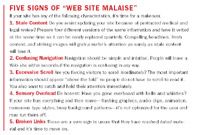Alternative Media: Spruce Up Your Site
You remember it well: that day back in the late 1990s, when your brand's Web site first went live. It looked great at the time, and you were so proud to have entered the Internet Age.
You remember it well: that day back in the late 1990s, when your brand's Web site first went live. It looked great at the time, and you were so proud to have entered the Internet Age.

Sharon Callahan
How many times since then have you enhanced the user experience, or refreshed the content and graphics of your Web site? Twice? Once? Not at all? Most companies, it turns out, are still hosting first-generation sites that were designed at the turn of the millennium.
Prudent brand stewards enhance the content on their Web sites at least quarterly and will redesign their sites at least once a year. Why? More than half of the visitors of a Web site decide whether or not to abandon it within the first 10 seconds of their visit. It takes just one experience with dated information for visitors to conclude they've hit a dead end or landed on an orphaned site.
Nip & Tuck
Whether its a quick face-lift or emergency surgery, work of any nature on your Web site requires a back-to-basics mentality grounded in sound Web strategy. Start by asking yourself a few questions.

Do customers come first? Once current and potential customers arrive at your site, they should easily find what they are looking for. Make sure your site has the information your customers need. If you're not sure what they're hoping to find, ask them what they would like to see on the Web site. Their answers may surprise you. This can be done through e-surveys (using e-mail addresses gathered from opt-in e-mail surveys) or from live polls on the site.
What is the call to action? What precisely do you want your customers to do when they visit your site? Do you make it clear to them how to request additional information, how to talk to their doctor about their condition, or how to sign up for your newsletter? Before you do anything new to your site, determine how you would define a successful visit for new and existing customers.
What is your competitive advantage? Before you begin the face-lift, research your competitors' sites and promotions to find out what is being offered. Once you've sized up the competition, determine what your competitive advantage will be.
Do visitors understand what is on the site? Patient insights should drive all of your work, online as well as offline. Tell your stories in the voices of patients. There's no question this approach adds credibility, but many sites don't use it. People relate to the stories others tell.
Is your site too pushy? It's OK to ask visitors to register to participate in message boards and the like. But visitors shouldn't feel you are asking for too much or invading their privacy. Web sites that fulfill requests for additional information should make online ordering fast, easy, and secure.
Is your site aligned with your brand? No doubt, you've evolved your marketing strategy several times over the past few years. Brands evolve as a result of a cohesive strategy conducted at a macro level. But Web sites usually grow in piecemeal fashion as new sections are added over time. As a result, brand positioning and messages are not always reflected throughout the entire site.
Is your work fully integrated? Your organization may be launching remarkable efforts in silos. There may be a new patient program, a successful new division, a new physician campaign. But great marketing is about more than just great programs and creative—it's about integration. Add the information to your site in a way that includes the full brand and company message. Activities undertaken in the offline world should always be evaluated for their appropriateness online.

FIVE Signs of "Web Site Malaise"
Optimize for Search
Healthcare has always been a popular subject for online users. Today, 95 percent of those looking for health information use search engines—and the Internet is the second-most important tool for finding health information, trailing only physicians.
In fact, each day, eight million American adults look online for health information—the same number that, on a typical day, pays bills online or uses the Internet to look up a phone number or an address.
So are these users finding your site? No matter how good your content or design is, if your site isn't optimized for search, the answer to this question is "probably not."
By using a combination of organic and paid search engine optimization tools, your organization can ensure that the patients, doctors, and consumers make it to your site. This technique involves choosing keywords that are well-suited for your site. Companies also can bid on premium keywords to guarantee a higher search-engine ranking (see "Search-Engine Marketing: Click, Click...Are You There?" in the March 2007 issue of Pharmaceutical Executive). For your organization, optimizing for search can translate into qualified Web traffic, higher brand awareness, and maximum ROI.
Once you get people to your site, your Web face-lift will keep them there.
Build a Social Network
There's no denying the drawing power of a compelling Web site—but introducing a user-interaction feature to your site can get visitors to keep coming back. Today, consumer-generated content is the fastest-growing segment on the Web. According to Visible Technologies, a Grey Healthcare Group alliance company, 1.5 million new consumer comments are written on the Web every 24 hours. As the Internet continues to evolve, the traditional paradigm of pushing communication to the user is no longer as effective as it once was. Instead, consumers and patients are using social-networking tools such as health-information forums and Web portals to search out information about their ailments.
By offering consumers the ability to leave comments on branded and unbranded blogs, Web forums, and traditional Web sites, you create a moving flow of information to complement your otherwise static site. Companies can spur dialogue by offering topics pertaining to a particular disease and ways to treat it. This type of Web environment helps build stronger relationships with patients by empowering them to share information with others.
Adding a social-networking component to your existing Web site, or partnering with an association to create a new one, can raise the value of your brand as more people want to participate with you and talk about the issues. If you want to start small, try adding the ability for visitors to leave comments on informational postings. Expand on this by implementing a Web forum where patients can register and write about their conditions so that other users can read and respond.
With social-networking technology, pharmaceutical companies can get a faster and better handle on the language and experiences of patients and physicians, and use that knowledge to better market to consumers. Having a Web site that facilitates patient dialogue will ultimately be a choice you have to, and should want to, make.
Time to Act
In just a short time, healthcare and the digital world have evolved considerably, taking the Web-marketing paradigm with them. Whether your Web site needs tiny tweaks or total brand realignment, it's time to get started. With the proper investment, your organization can reap the rewards of growing customer engagement, stronger brand loyalty, and deeper public trust.
Sharon Callahan is president of Summit Grey. She can be reached at scallahan@ghgroup.com

Is Artificial Intelligence a ‘Product’? Products Liability Implications for AI-Based Products
April 10th 2025As the physical products we use evolve to become increasingly complex, traditional products liability frameworks may not always fit to provide remedies for harm that can result from using novel product types.